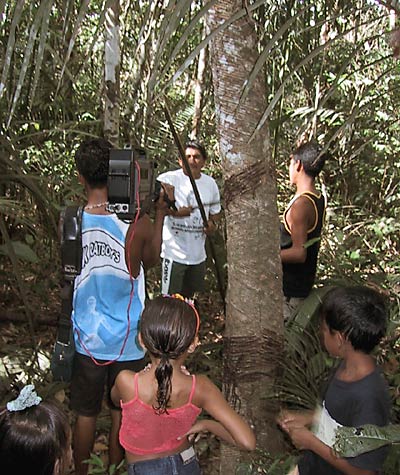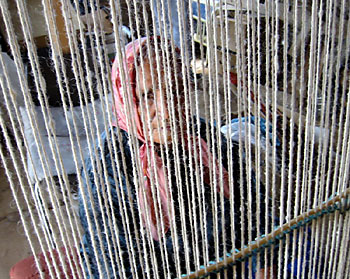Greenstar delivers solar power, health, education and environmental programs to small villages in the developing world, connecting those people and their traditional culture to the global community.
Greenstar Corp. and the Greenstar Foundation were co-founded by Charlie Gay, former director of the U.S. Department of Energy's National Renewable Energy Laboratory, and Michael North, whose company -- North Communications -- built hundreds of public access electronic commerce solutions. North is also the president and CEO of Greenstar.
To deliver its services efficiently and quickly, Greenstar designed a portable community center. Using solar power generated by large photovoltaic panels, the center can drive a water purifier, a small clinic, a vaccine cooler, a classroom, a digital studio and a satellite or wireless link to the Internet.
The group works with the people of each village to develop an e-commerce Web site, employing local musicians, teachers and artists to record the voice of the community. Greenstar packages the materials for various markets, both direct to the consumer and through licensing to businesses. This formula provides new jobs and skills, strengthens local culture and language, and affirms the community's independence. Villagers own the Greenstar Village Center and become shareholders in Greenstar.
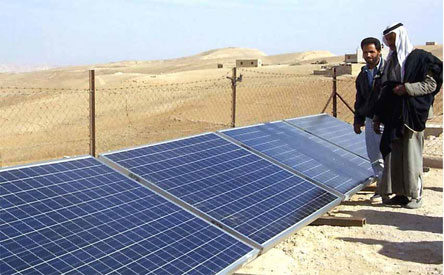 |
|
Leaders of Al-Kaabneh, a Bedouin village in the West Bank, survey the large solar power modules provided by Greenstar.
|
To date, Greenstar has completed pilot installations in a remote Bedouin settlement on the West Bank in the Middle East, in a small community in the Blue Mountains of Jamaica, in the central India village of Parvatapur, and in a traditional Ashanti community in Ghana. Centers have been started in New Mexico, Brazil and Tibet, and new ones are development in New Mexico and Hawaii.
In another 60 communities around the world, Greenstar has developed connections with people aimed at building a network of people, skills, ideas, tools and cultural voices that it says "will be of incalculable value to the whole world in the years ahead."
The company maintains a small, decentralized network of offices in Los Angeles;Oahu; Washington, D.C.; Cairo; and Hyderabad, India.
Interview with Michael North,
President of Greenstar
Q: Is the financing method for these village centers one thing that sets Greenstar apart from other organizations?
A: I believe so. What we do is first identify these remote communities. Usually, in fact, they identify themselves to us through different international organizations. We then set up a procedure whereby they design their own community center. We show them what tools are available and discuss their needs. Essentially they design the community center based on what they feel their needs are, and then we supply it.
Probably most unique is the way we pay for this. The most remote villages nestled in the highest mountains, or in the middle of the widest deserts and in the center of the deepest jungle are the places where people are most in touch with their traditional cultures. Here their language and their music and their vision of the past and the future --the ways of community leadership and traditional healing and their myths and legends and their stories -- are the purest and most clearly linked to the way they originally evolved. They haven't been too much impacted by modern industrial culture. McDonald's hasn't franchised them yet.
We think those cultures, or those expressions of culture -- especially the music -- have tremendous inherent value for all people on earth, as well as for the people who originated them -- those who are heirs to them. Sometimes these traditions are thousands of years old. They are part of the common heritage of all humanity, and in that regard alone have tremendous value. It is Greenstar's job to help these communities translate that value, at least partly, into economic terms so their people can get some of the basic services they need and want.
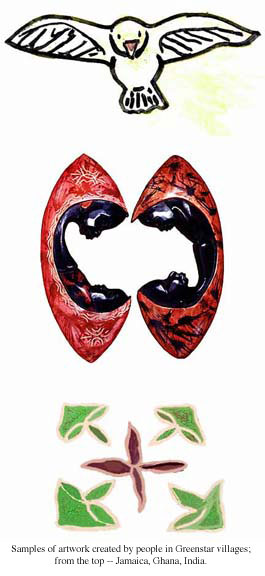 Q: Are you essentially going into business with these communities, helping them sell what they have that is unique as a means to provide services they need? Q: Are you essentially going into business with these communities, helping them sell what they have that is unique as a means to provide services they need?
A: Exactly. The services they get are all based on green technologies, as well as sustainable development principles. So they are not getting bolted onto a grid, and they are not becoming slaves to modern utilities. They are not being made dependent on government. We are providing what we call “tools for independence” for a village. This is a key phrase we repeat again and again. The goal here is to make it so a village is more independent of other villages, towns and cities around them, more independent from the national government and so on.
From our perspective, for most people in remote places in the developing world, the root cause of many of their serious problems is that they are disconnected. They are isolated. This is the reason they are hungry. This is the reason they don't have health care. This is the reason they are illiterate. This is the reason they have diseases that rage through the community. This is the reason they are attacked by military and political figures. This is the reason they are exploited economically. This is the reason their young people leave these remote villages and try to go to the big cities where they become nameless and lose their identity.
All of these things are symptoms of the same problem, which is that when you live in these places, you are isolated. You have no connection with the outside world, no ability to make a phone call, and no ability to connect to a computer network. You have no ability to provide feedback on your needs to the government, to a university, to a hospital, to a doctor or to anyone. You are simply a victim as a result of isolation.
As we have seen repeatedly in history, the strong will always victimize the weak. So Greenstar is trying to create a situation where these remote communities become a source of their own power. They become the source of their own dignity. They have tools for independence so they can stand up for themselves to a greater degree.
We do this by helping them set up a little business based on their music and their artwork, a business that earns them hard currency; that’s the just the beginning of a whole chain of independence events in the economic, social, cultural, health and education domains. They aren't simply earning the currency of their own country. They are earning U.S. dollars or British pounds or Euros. In many of these countries, this hard currency has tremendous value.
Q: What do you regard as some of the biggest mistakes to avoid?
A: Relying on top-down, center-out tools, technocracies and bureaucracies–. The whole international framework of financial management, government organization, international trade, the international aid game -- the whole thing -- is based on the need to pay the salaries of bureaucrats in New York and Geneva. It is not built primarily to provide real assistance, real tools, real independence, real durable and lasting results. The whole structure is built to provide politically palatable statistics for the people who write budgets in Washington and London and other major capitals.
But it's all built on good intentions. Corporate and NGO [non-governmental organization] programs, the United Nations and international aid are all built on extremely good intentions -- on the part of the people who work in those organizations in the field offices.
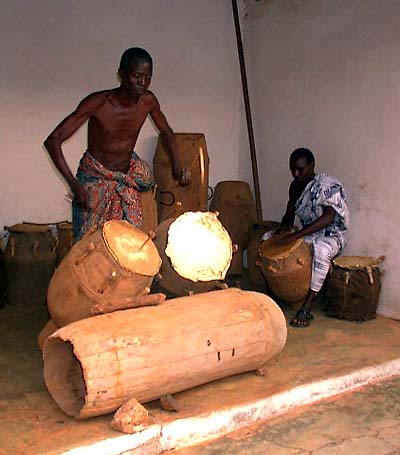 |
|
Master drummers in the Ashanti tradition of Ghana perform at Greenstar's "digital culture festival" in Patriensah.
|
But by the time those good intentions get translated through headquarters budget and political processes, they go through all the compromises, the honing of schedules and deliverables, what is palatable to this congressman or that delegate or this or that faction, and the trade-offs against international political objectives -- by the time everything gets filtered through all of those centrally controlled instruments -- what actually ends up being delivered in a remote village in Ethiopia or Cambodia or Peru often bears little resemblance to what was originally designed or intended by the people who run the program.
So our approach is to invite the people at the other end of the telescope -- the real people -- to design the program. They are going to create the economic engine. They are going to initially benefit. In fact, that process of designing it themselves and finding their voice and expressing it to the world -- this is the fuel of the business engine in terms of finance and viability.
We try to make it so all those other external agendas are less in control. We don't answer to masters who demand that we provide other deliverables. Organizations like the World Bank, the United Nations Development Programme and various private organizations, as well as the G8 and the Canadian and American aid organizations are starting to recognize the results they get for the investments they make are less than they could be. They are beginning to recognize there is something short-circuited about how they have been conceiving of international development and what its goals should be.
Q: Do aid programs often help for a while, but end up leaving people worse off than they were before in some respects?
A: Short-term aid can make things worse in that it creates expectations, it creates illusions -- and then it creates disillusions. That makes it harder for anyone to come in later with some new idea to help. Everybody just rolls their eyes and says, "We've seen this before. We've heard this before."
One of the few things that people have in an isolated poor place is hope. If you give them hope, that's great. If you take it away, it is really tough. I'm not sure I would be so absolute as to say it is better never to have given them hope in the first place, because anybody who does anything that has a positive goal should be praised. I don't think anything is ever wasted. But it is tragic to see so much financial capital, human capital and time lost in the backwash.
Q: Is there a view of how technology can really help these remote areas embedded in your approach?
A: We rarely ever talk that way. We rarely ever consider what the role of technology is. We don't think that way. Our clients are the people in the village. If a piece of technology is useful for them, great. Very often, the simpler the technology, the tougher it is, the more durable it is, the more flexible it is, the easier it is to produce locally and maintain locally, the better. The solarpowered bakery we put out in Afghanistan has no moving parts. All you have to do is keep the mirrors free of dust. There is nothing to break. So really what we are looking for in technology is something that is actually going to work in a tough environment.
In some places, we could provide celphones in a village because they are within 50 or 60 miles of a commercial network. They may be way off in the jungle, but with an additional repeater, for example, you might be able to put a cell phone in a remote village. They could then make phone calls; that sounds good, right? But it is so easy for that solution to break down, for the phone to get messed up, for them not to be able to pay their bill. It is so easy for the cell repeater to go down. It is so easy for the cellular system in the country itself to go down. So really, it makes a lot more sense simply to put in a satellite system that goes straight up into space.
But we are practical rather than ideological. Sometimes, like in Ghana, we've gone through an initial phase of starting people off with cell phones. Now we are upgrading there. The point is to get results that are tangible as soon as possible rather than follow any ideological program.
We have no technological ax to grind. We are always looking for stuff that is tougher, simpler and cheaper. Our criteria for a good technology are really different from the criteria used for equipping an office in downtown Los Angeles, for example. You have to be able to take one of our computers and bounce it off a hard rock and have it come up and still work. Once you have spent all this time and money to get the computer out there, if it is bounced off a rock and doesn't work any more, you really don't have much use for it.
Q: What results have you have seen when you install these community centers?
A: I think the main impact is that they see there is a world out there that they share interesting things with, a world that is interested in them, that they can speak to and that will speak back to them. They see they are a valuable part of the world community.
In these isolated places, they may be poor. But they usually are not in despair. They don't think of themselves as being separate. If anything, they think of themselves as being in the center. Wherever you live and wherever you are brought up, you live in the center of the world. For them to see that all the other people out there, people they previously have tended to think of as the "enemy" ...
Q: Or perhaps as outsiders?
A: Yes, outsiders who exploit them. But suddenly they see that there are a lot of ordinary people with whom they share a great deal in common. There are people out there who value who they are, and they value those people for who they are. They can see their differences and understand the importance of that diversity.
That has a really powerful effect on a little village in the Middle East, for example. It has a powerful effect on the women who are marginalized in a small village in the West Bank.
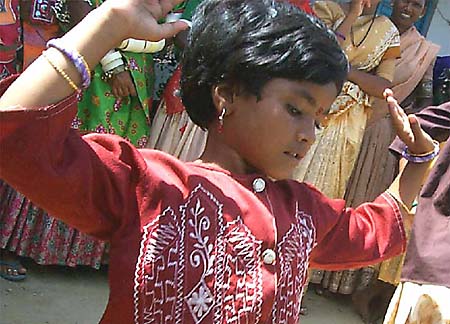 |
|
A young girl practices her people's Telugu dance traditions in Parvatapur, Andhra Pradesh, a small village in central India.
|
It has a powerful effect on the kids. The kids hear about what goes on in the rest of the world, and their usual response is, "I want to get out of this place as soon as I can. There is no future here for me." But the Internet has a powerful impact on them -- they see that the rest of the world can come to their village and understand and respect who they are.
Q: So the people in the village will put up their own Web pages?
A: It is very easy for them to put up a Web page. We teach them how to do that and a lot more.
Part of the centerpiece of the program is to teach them how to use digital cameras and digital video, how to do editing, use Photoshop, and how to express themselves. If they have never seen a computer, they don't have to overcome the idea that it is some kind of technology tool. They have never heard this word, “technology”. They have no more inhibition about using it than any other tool. It could be a hoe. It could be a rake. It could be a new kind of knife. It is just a new tool.
We teach them that it is a picture and sound tool. It is not about numbers, computer science and mathematics. You don't need to have any particular skills to use it, you just need to be able to pay attention to it. If you do, it more or less teaches you how to use it.
We avoid giving people structured classes in how to use the computer. We go straight into, "Here's how you find this kind of information." If you are in Syria, and you are looking for information about Syria, here's how you find the information. Here's how you get a download. Here's how you see the video. We don't teach them “the fundamentals of the Windows operating system”. In fact, we avoid that as much as possible.
Q: So they take to high-tech tools fairly rapidly and really just start using them?
A: Anything else slows them down. The first time I left a computer in a village with the Bedouins in the Middle East, I came back a few months later and the computer started up by showing scenes from Mecca and playing the first five verses of the Koran. They used this as the startup routine. No one taught them how to do that. No one even gave them the concept of something automatically happening on startup. Nobody told them; they discovered it.
Or another example: The first thing a teacher in Al-Kaabneh wanted to do once he had a computer with a printer hooked up was print out his lesson plans. There were other teachers in a couple of nearby schools -- just a couple of hours walk away -- that wanted to have his lesson plans, but he had no easy way of sharing them before. It was just too much of a hassle to write it out by hand for each of these other teachers. But he typed it all up, printed off six copies and put them in his backpack. Next time he went off to the other villages, he passed out the lesson plans. We didn't tell him to do that. In fact, we wouldn’t even have thought of printing lesson plans as a primary educational benefit. But this teacher knew right away what was useful.
People who live where resources are tight have to use their brains a whole lot more than you and I. They are smarter. They are more resourceful and tougher than we are. They are much more patient. So when an obstacle comes up, they tend to know how to think their way around it. They know how to come up with quicker, better, smarter ways of doing things than you and I because that's the way they have to train themselves from birth -- to work with their environment and use their intelligence to get value and susstenance from it.
Q: Is this economic model actually making money for the centers you have put out there?
A: They make money from the first dollar. If we sell one CD, they make some money. Even a small amount of hard currency goes a long way. In Jamaica, the salary of a teacher for an entire year is $400. So when I went there a couple of years ago and gave one community their first royalty check of $200 for a product that had just been out for a few months, this was like a miracle to them.
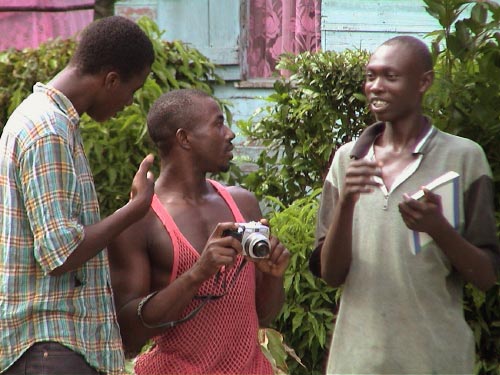 |
|
Students in Swift River, Jamaica learn to use a digital still camera as part of Greenstar's "digital culture" program.
|
In Jamaica, the school/community center/clinic, which is all in one building, was connected to the power grid. They already had regular electricity. Power poles had been run out to this remote village because Jamaica has been pretty ambitious in its rural electrification program. But there are problems with this. First of all, the electricity goes down three or four times a week and stays down for anything from 10 minutes to half a day. So they are never quite sure when they are actually going to have electricity. The other problem is electric power is very expensive in Jamaica.
It costs nearly $1,000 a year for electricity for this building. So by putting a solar-powered community center in the building, they are not only earning hard currency from media sales, they are also getting free, reliable electricity to run the center. They have the option of using solar or using the grid power. They never use the grid power. They have a switch inside the community center that says “solar” on one side and “grid” on the other. That switch is firmly taped over onto the solar side. They have learned, and never want to pay another electric bill.
Q: Can you give a general idea of a Greenstar community center's cost?
A: By the time we get people out there and cover the shipping and do the training and have our digital culture festival, by the time we do the editing and have products ready to market, the cost generally runs around $50,000. That's not a lot of money when it comes to conventional aid budgets. But this is all privately financed, so it is significant for us to be able to raise that amount [from investors]. An investor in Greenstar is investing in a company that owns the rights to market these timeless, precious cultural assets. So when you buy a share in Greenstar, you are buying participation in the traditional cultures of Tibet and Brazil and the West Bank and India. You are buying a share in the total growing library of cultural assets.
Q: Has anyone else taken a similar approach?
A: I don't know anyone else who has taken this comprehensive, end-to-end approach. There are organizations doing solar powered community centers of different kinds, and telecenters with computers and Internet connections. There are organizations doing world music and art and cultural work. But I don't know of anyone who has connected all these dots to make the same whole.
Q: So even with the new connectivity, culture still remains very distinct?
A: It hasn't been homogenized. In Western culture, everything is an imitation of something else. If you watch TV, if you watch commercials, if you look at ads in a magazine, almost everything is copying or mocking something else in some way. That is the whole postmodern style of the culture we live in, in the West.
Rarely do you connect with something that is real in the original sense of the word -- that is authentic, that is undiluted, that is not an ironic comparison of itself with something else. I think it is really important for us to maintain contact with those original yardsticks because they are cultural roots from which we all came. I'm not romanticizing people in far off places here.
We are trying to do some of that kind of thing with the roots of Western culture as well. There are places where our cultural roots are still alive, although they are vanishing fast. For example, we are trying to do a project with some remote Acadian communities in Nova Scotia and New Brunswick. That goes back pretty far -- 300 or 400 years. At the same time, we are looking at a project in the upper Bayou of Louisiana. We are doing projects with Native American and Canadian people. We started our first project with the Navajo in New Mexico a few months ago. We've been discussing a project in the remote parts of Finland. There is some amazing work to be done all over the former Soviet Union, in Bulgaria and other regions.
The developing world is everywhere. There are remote villages and traditional cultures everywhere.
Q: To be honest, we have to admit the developed world isn't in such great shape either. We seem to be confronted by crisis at every turn.
A: You've noticed. The fact that we happen to be more materially prosperous doesn't seem to necessarily make us happier or more fulfilled or make our families better or stronger. In some ways, it seems to make us sicker. So we shouldn't presume that we know all the answers and our job is to somehow contribute some of our wealth so other people can discover the wonderful answers we've discovered.
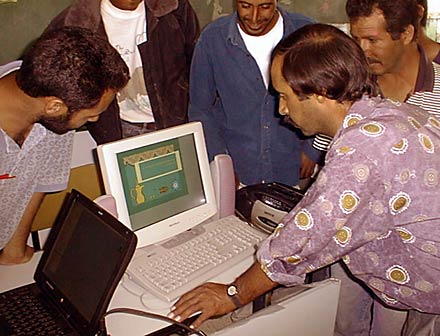 |
|
Teachers in the West Bank set up their new solar-powered touchscreen computer.
|
Believe me, out there in the world, they don't think that way. They look at America and Europe and see a lot of good. It is good that people aren't starving to death as much, but people in the developing world aren't sure they want the whole package.
They have a very sophisticated analysis of Western culture. They come from cultures that are a lot older than ours. They see us as clever monkeys. They see us as being angry children with far too many resources -- militarily and economically -- and lacking the wisdom to use them.
Q: In these old cultures, wisdom is a quality to develop?
A: Yes, that's the goal. Old people are respected. They've spent the time to achieve that. They have been through all the lessons and seen all the events of life, and now they have something to teach. That is the goal -- to go through all the different stages of life and then pass on what you've learned.
I'm not sure I would romanticize this as "wisdom" -- it sounds so ponderous -- but when you've gone through being a child, being an adolescent, being a mother, raising children and putting them into the world, having grandchildren and earning a living, owning property and planning for the future -- you have gathered the stories and the music and the events of life as treasures. And then you pass them on to other people. That's what these cultures are -- the result of scores of generations, thousands of years of that layering of experience.
So old people in a traditional village are proud of their wrinkles. They wouldn't give away their wrinkles for anything. They have worked too hard for them. People in isolated families and communities know a lot more than we give them credit for about what they need. That is especially true the smaller you get.
We've found that if we keep the size of the communities we are working with below 5,000, then we have a community where a lot of people are going to know each other by face and by reputation. They are going to know each other by family. In a village that size, you really have a series of clans that are all interrelated families. So people have a day-to-day practical understanding of what the problems are in the community. If there is bad water, everybody knows about it. If there is a shortage of firewood, everybody knows that is a major problem. If there is measles going through kids at school, everybody knows about it. And they develop answers.
They may not be the most effective answers, and they may not be the best answers, but they develop a strategy together for dealing with problems. In our society, we can learn from this: if we could bring our decision-making down to that face-to-face living level, we would be healthier, all round. If we could apply that principle to our ways of political organizing, and bring real power in making decisions down to units that small, where people know each other, we might adopt some very different approaches. In villages like this, people are much closer than they are here.
In a big Western city, you can move into an apartment and not even meet the person who lives next to you for 10 years. That would never happen in a small village. If you arre a stranger, the minute you get within shouting range, people already know you are there. They are already trying to figure out who you are, how you fit in, who you are related to, who has brought you there, who vouches for you, what religion you are and so on.
They have a very sensitive social organism. If we could learn to live and think that way, so we care about each other on that level, so we know about each other and we act together on that level, then I think some of our wealth might be put to better use.
We have a lot to learn. There is a real exchange of value here. We are not giving something to these poor people in helping them to get better water, free themselves from disease, learn how to read books and so on. This is not charity. We are going there with our ears and our eyes open.
We are listening and learning. We are gaining at least as much in value as we are giving. I'd like to encourage other people in the world to think that way too.
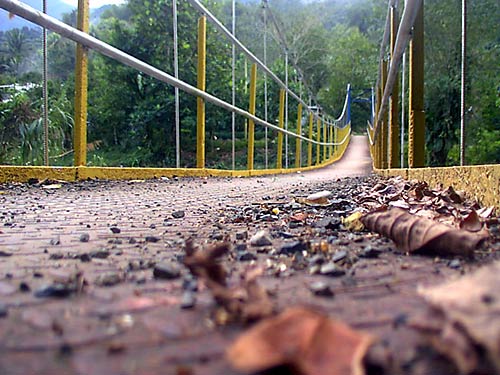 |
|
A photograph taken by a student in Jamaica, capturing what it's like to cross one of the famous "hanging bridges" found in the Blue Mountains region.
|
Sidebar: More detail
|


 Q: Are you essentially going into business with these communities, helping them sell what they have that is unique as a means to provide services they need?
Q: Are you essentially going into business with these communities, helping them sell what they have that is unique as a means to provide services they need?




